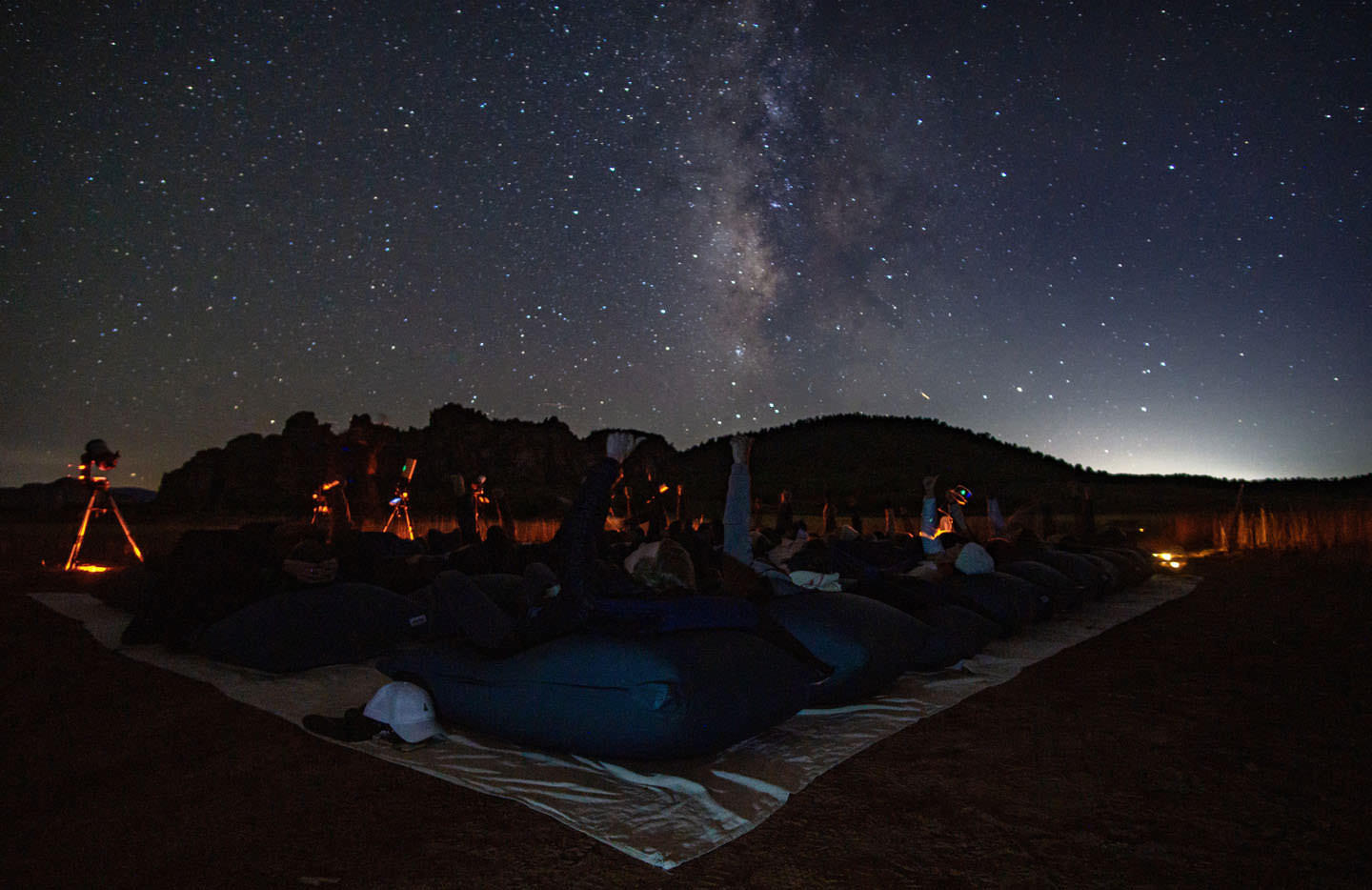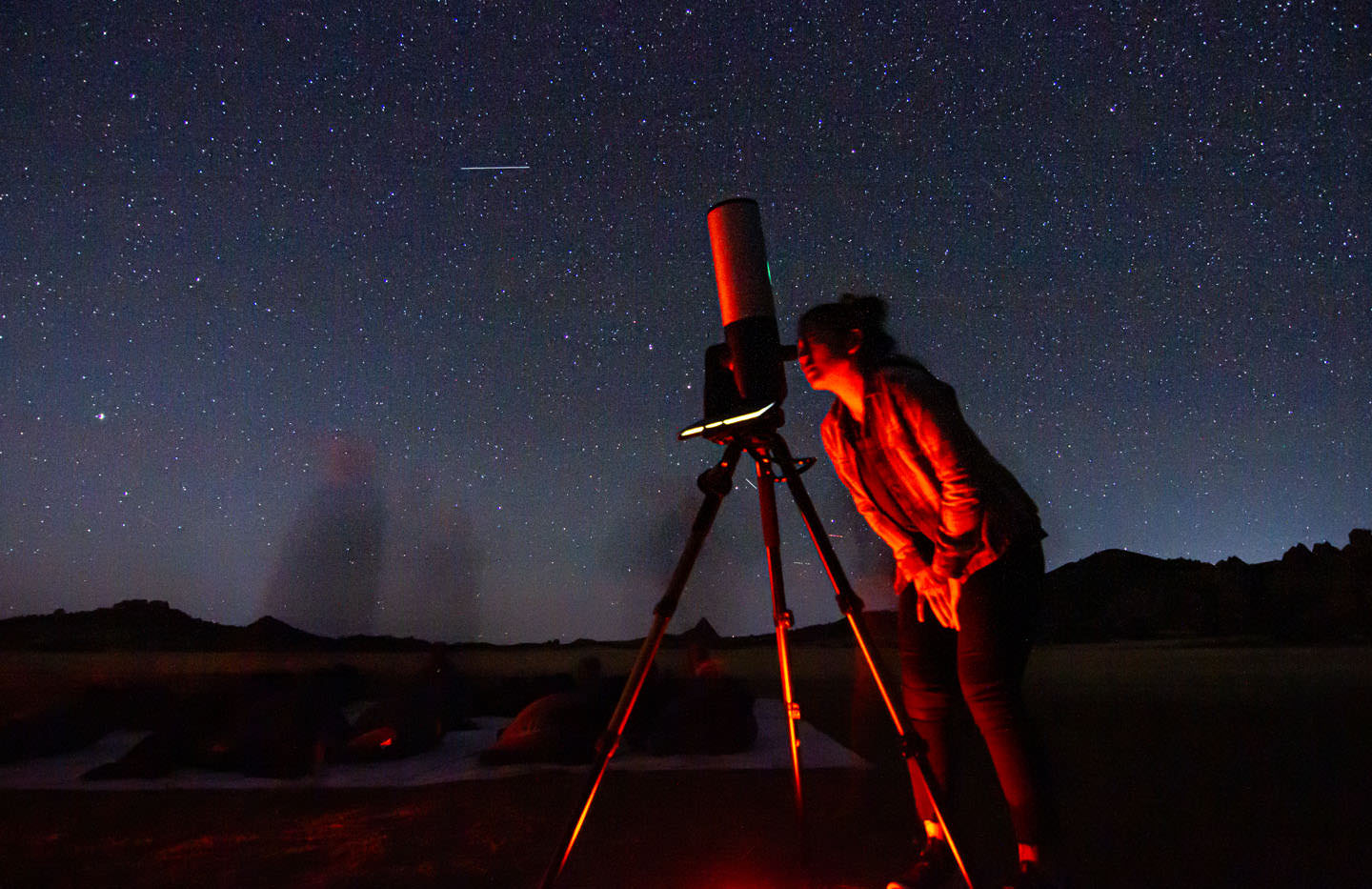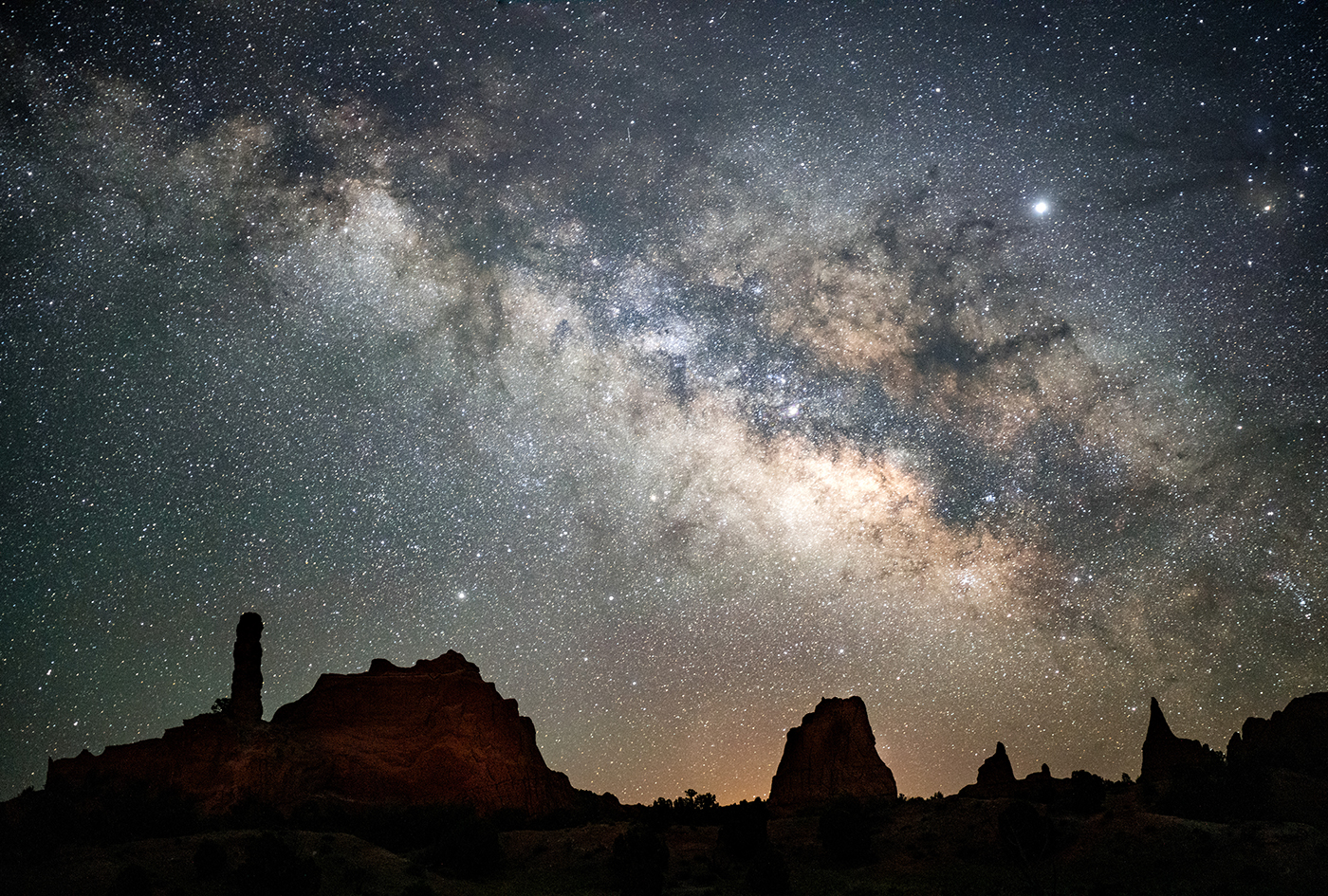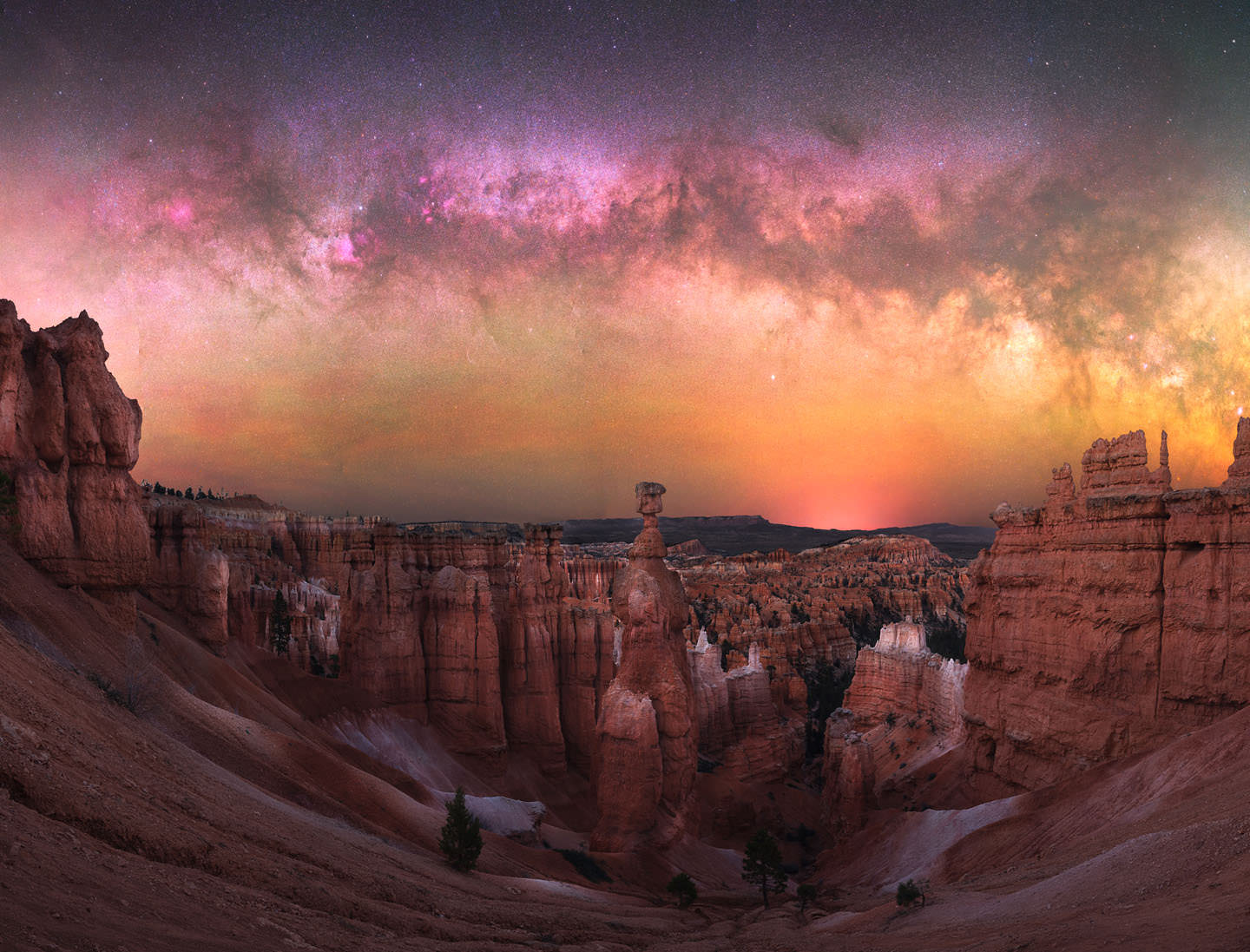Surrounded by velvety aubergine darkness, I walk between Saturn and Jupiter. My path is lit by the softly glowing orbs, which aren’t suspended in the sky but laid out to scale in the red dirt of southern Utah, a stone’s throw from Zion National Park. I stop at the coppery gleam of the solar system’s biggest planet, with 95 moons. Astronomy guide Macy Reed describes Galileo gazing up at Jupiter in 1610 and realizing it was orbited by four of these moons—a revelatory moment that “it’s not all about us.”
A dark sky puts things in perspective. As if on cue, coyotes yip nearby, the wind blows, and clouds roll in, obscuring any sign of planets or stars above. Unlike Galileo, I won’t be glimpsing Jupiter’s moons tonight.
In my open-to-the-sky star bed, the celestial lights are so bright that the Big Dipper glitters like a dangling chandelier above my head.
My first night of stargazing in a place renowned for it—Utah has 25 certified dark-sky places, more than anywhere else in the world—is under an overcast sky. Sirius, the brightest star in our sky, winks before being veiled by a wisp of cloud. I follow the sandy path mirroring our planetary system to a tiny, silvery Mercury and a cluster of high-tech telescopes and zero-gravity bean-bag loungers at the base of Cave Knoll, a jagged Navajo Sandstone formation. This is where Stargazing Zion’s grand finale usually culminates in sightings of Saturn’s rings and the Owl Nebula.

Stargazing Zion guests viewing the Milky Way near Cave Knoll outside Zion National Park. Photo courtesy of Stargazing Zion.
I lie down on a bean bag and stare at the cloud cover that “almost never happens.” I try not to take Sirius’s rejection personally, thinking of Reed’s words about Galileo’s epiphany: It’s not all about us. The Diné (Navajo) concept of hózhó is another take on this: Be one with nature, in harmony with the surrounding universe. On the walk back to the parking lot, I retrace my steps to the outer reaches of Reed’s improvised and battery-powered galaxy, walking without a flashlight like my mom made me do as a kid when we camped in the wilderness. “You’ll see more,” she’d say. But it’s almost too dark with the stars still playing peek-a-boo.
An hour later, the cloudy canopy lifts, and I see what an immaculate night looks like in Utah. Outside my luxe glamping tent at Open Sky Zion on the lower slopes of a mesa close to the national park, I crane my neck and gasp at the creamy crescent of the Milky Way. In my open-to-the-sky star bed, the celestial lights are so bright that the Big Dipper glitters like a dangling chandelier above my head.
I lie supine with my eyeglasses on to clearly see the stars, but even when I remove them every one of the Big Dipper’s seven points is visible. Thoughts tumble in my head. Can I cure my nearsightedness by staring at the stars? Is my mom outside without a flashlight, looking up at the same stars thousands of kilometres away? Is my dad among them? Hi, I miss you. I’m floating, even without the zero-gravity bean bag. Hózhó seems tangible, and I reach up with my fingertips as if to pluck Alioth, the brightest blueish-white star in the Big Dipper.

A guest looking at the Dumbbell Nebula. Photo courtesy of Stargazing Zion.
The sky stays inky and translucent the rest of my time in southern Utah. Along Scenic Byway 12, also known as A Journey Through Time Scenic Byway, the geology on display—180 million (or so) years—is as vast as the stars above at night. In Bryce Canyon National Park, the hoodoos are giant gleaming wax-drenched candlesticks. Toadstools, slot canyons, and mesas adorn the Grand Staircase-Escalante National Monument. The arches, monolithic spires, and multihued variegations of the Navajo Sandstone layers—from white to coral to crimson—become a sepia-toned backdrop of gnarly and lunar-like silhouettes when darkness descends.
The dramatic landscape and dark-sky preservation efforts—as well as the rise of high-end glamping spots—have made Utah a go-to for stargazing. All “Mighty 5” national parks are dark-sky certified. The state is part of The Great Western Starry Way in the Intermountain West tract between Canada and Mexico that includes more than 80 dark-sky places (parks, reserves, sanctuaries, communities, and tribal nations) certified by DarkSky International (formerly known as the International Dark-Sky Association).

The nonprofit was founded in 1988 to preserve dark skies by minimizing light pollution and educating the public. In urban environments—like downtown Vancouver—I might see only
3 per cent of the thousands of stars that should be visible at night (and maybe the amber glow of Venus). Almost 80 per cent of the world lives in perpetual twilight and never sees a naturally dark night sky; that number rises to 99 per cent in the U.S. and Europe. And a third of people on the globe can’t see the Milky Way with the naked eye.
To witness the gilded belt of the Milky Way—a spiral galaxy with some 200 billion stars bulging around a supermassive black hole—is a form of hózhó. And worth travelling for, as the growth of astrotourism attests. “If people can’t see the stars, they will go and find them,” says Justina Parsons-Bernstein of Utah State Parks. “These astrotourists are coming to Utah from all over the world because they want to be out in the pristine darkness and see the Milky Way for themselves.”

The list of dark-sky places keeps growing: there are now more than 160,000 square kilometres of protected land and night skies in 22 countries on six continents—through DarkSky alone. (The Royal Astronomical Society of Canada has its own Dark-Sky Sites Program, which is separate from DarkSky’s designations.) And the events in and around these dark-sky places keep growing too, from astronomer-guided stargazing to star parties and festivals. The total solar eclipse that took place earlier this year is rare (the next one won’t be visible in North America until 2044), but other nightly spectacles beckon—like the Perseid meteor shower that dazzles with up to 100 meteors an hour (this summer, the peak is during the wee hours of August 13).
In Utah, the stars are so thick, it’s hard to pick out the constellation I usually find first: Orion. I look for him in the remote setting of Under Canvas Lake Powell-Grand Staircase, named the world’s first DarkSky-certified resort last year. Here, above Elephant Slot Canyon, I murmur the mantra “abundance is everywhere” in a yogastrology class at sunset. After dark, I return to lie in shavasana on the yoga platform—now a sensory bath. It’s as if I’m in a massive snow globe, inundated with shimmering stars, inhaling the earthy scent of petrichor, warmed and cooled by the desert breeze, and almost purring with a tranquil hum.
I’m miniscule yet monstrous, and acutely aware that “it’s not all about us.” Galileo knew this, as did Vincent van Gogh centuries later when he painted the otherworldly whorls of The Starry Night, the third-most-visited artwork on Earth with a stars-worthy annual visitation of three million. He said, “I know nothing with any certainty, but the sight of the stars makes me dream.” In the dark of night, stars and imaginations alight.

Read more from our Summer 2024 issue.









